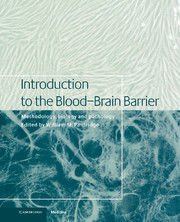Book contents
- Frontmatter
- Contents
- List of contributors
- 1 Blood–brain barrier methodology and biology
- Part I Methodology
- 2 The carotid artery single injection technique
- 3 Development of Brain Efflux Index (BEI) method and its application to the blood–brain barrier efflux transport study
- 4 In situ brain perfusion
- 5 Intravenous injection/pharmacokinetics
- 6 Isolated brain capillaries: an in vitro model of blood–brain barrier research
- 7 Isolation and behavior of plasma membrane vesicles made from cerebral capillary endothelial cells
- 8 Patch clamp techniques with isolated brain microvessel membranes
- 9 Tissue culture of brain endothelial cells – induction of blood–brain barrier properties by brain factors
- 10 Brain microvessel endothelial cell culture systems
- 11 Intracerebral microdialysis
- 12 Blood–brain barrier permeability measured with histochemistry
- 13 Measuring cerebral capillary permeability–surface area products by quantitative autoradiography
- 14 Measurement of blood–brain barrier in humans using indicator diffusion
- 15 Measurement of blood–brain permeability in humans with positron emission tomography
- 16 Magnetic resonance imaging of blood–brain barrier permeability
- 17 Molecular biology of brain capillaries
- Part II Transport biology
- Part III General aspects of CNS transport
- Part IV Signal transduction/biochemical aspects
- Part V Pathophysiology in disease states
- Index
9 - Tissue culture of brain endothelial cells – induction of blood–brain barrier properties by brain factors
from Part I - Methodology
Published online by Cambridge University Press: 10 December 2009
- Frontmatter
- Contents
- List of contributors
- 1 Blood–brain barrier methodology and biology
- Part I Methodology
- 2 The carotid artery single injection technique
- 3 Development of Brain Efflux Index (BEI) method and its application to the blood–brain barrier efflux transport study
- 4 In situ brain perfusion
- 5 Intravenous injection/pharmacokinetics
- 6 Isolated brain capillaries: an in vitro model of blood–brain barrier research
- 7 Isolation and behavior of plasma membrane vesicles made from cerebral capillary endothelial cells
- 8 Patch clamp techniques with isolated brain microvessel membranes
- 9 Tissue culture of brain endothelial cells – induction of blood–brain barrier properties by brain factors
- 10 Brain microvessel endothelial cell culture systems
- 11 Intracerebral microdialysis
- 12 Blood–brain barrier permeability measured with histochemistry
- 13 Measuring cerebral capillary permeability–surface area products by quantitative autoradiography
- 14 Measurement of blood–brain barrier in humans using indicator diffusion
- 15 Measurement of blood–brain permeability in humans with positron emission tomography
- 16 Magnetic resonance imaging of blood–brain barrier permeability
- 17 Molecular biology of brain capillaries
- Part II Transport biology
- Part III General aspects of CNS transport
- Part IV Signal transduction/biochemical aspects
- Part V Pathophysiology in disease states
- Index
Summary
Introduction
For several reasons researchers have tried for many years to establish a tissue culture model of the blood–brain barrier (BBB). For ethical reasons the amount of animal experiments should be limited to a reasonable number, and a further consideration is that by simplifying an experimental setting, conditions are much easier to standardize. Because a living animal is of course a complicated organism, many researchers support the idea that isolated brain capillary endothelial cells (BCEC) in culture are a suitable model system, which can be brought to standard conditions more easily, but still give valuable information on how the BBB actually works.
A functioning in vitro model of the BBB should display most, if not all, properties of the barrier in living animals. Among these properties are a very high electrical resistance, due to the presence of tight junctions, in other words a very low paracellular permeability for hydrophilic compounds (including ions), expression of BBB-specific marker proteins, and a cellular polar distribution between luminal and abluminal endothelial plasma membranes of these marker proteins, including transporter proteins.
By isolating BCEC and culturing them, these cells keep their endothelial phenotype, still displaying typical properties. They express angiotensin converting enzyme, von Willebrand factor, and internalize acetylated low-density lipoprotein.
Regrettably, BCEC lose BBB-specific features that they possessed in vivo.
- Type
- Chapter
- Information
- Introduction to the Blood-Brain BarrierMethodology, Biology and Pathology, pp. 79 - 85Publisher: Cambridge University PressPrint publication year: 1998
- 5
- Cited by



